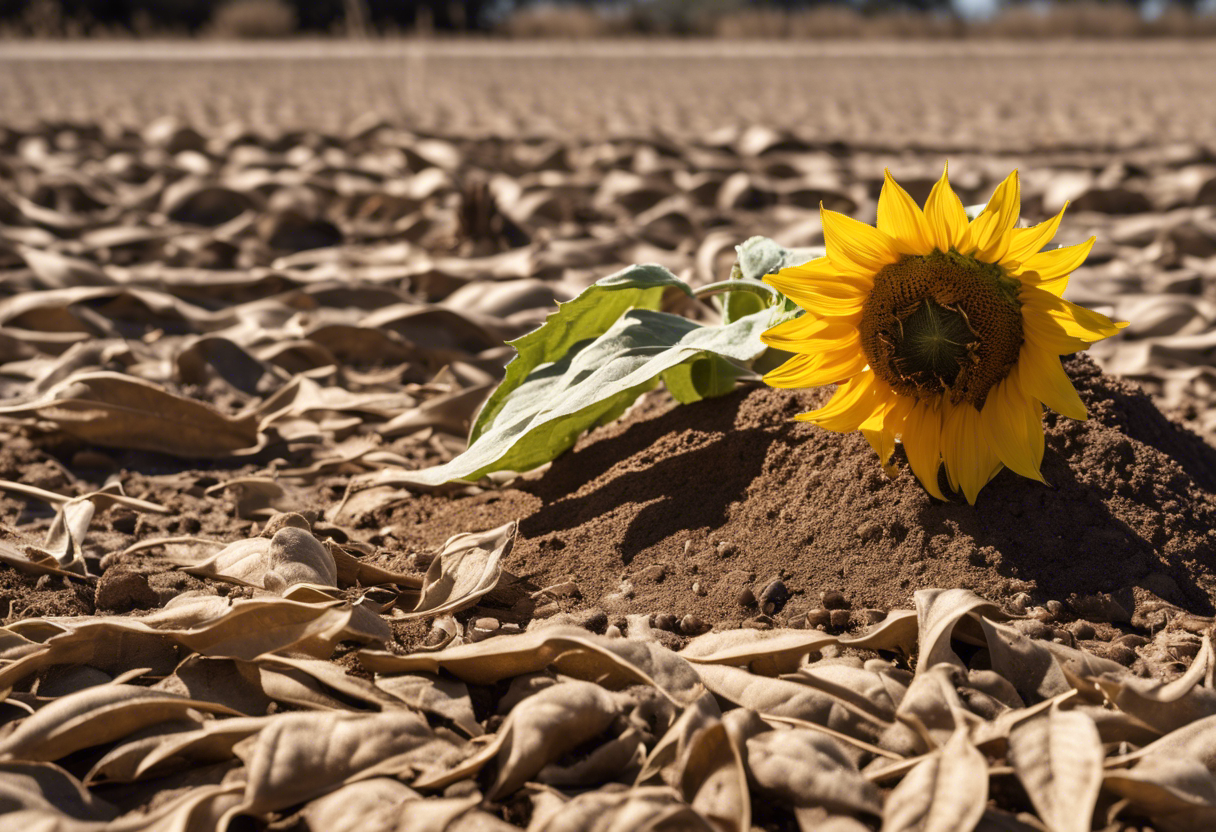Hey there, green thumbs! Ever found yourself in a sunflower slump, staring at your wilting yellow buddy and wondering how to Revive Dying Sunflower? Trust me, I’ve been there too. It’s like watching a sun set too soon, right?
But don’t worry! You’re not alone in this. Many of us have faced the same challenge and come out victorious on the other side. So buckle up, because we’re about to embark on a journey to bring your sunflower back from the brink. Keep reading about ‘Sunflower Dying? (How to Revive it)’.
Key Takeaways
- Identify the problem: Check for signs like yellow leaves, wilting, or stunted growth.
- Correct watering: Overwatering or underwatering can harm your sunflower. Adjust accordingly.
- Nutrient deficiency: Use a balanced fertilizer to replenish nutrients in the soil.
- Sunlight exposure: Ensure your sunflower gets 6-8 hours of direct sunlight daily.
- Disease and pest control: Treat with appropriate pesticides or fungicides if necessary.
- Repotting: If root-bound, repot the sunflower in a larger pot with fresh soil.
Understanding Sunflower Health
To revive a dying sunflower, you first need to understand sunflower health. It’s like being a plant doctor, diagnosing the problem before prescribing the cure. Recognizing dying sunflower symptoms is crucial, as is understanding the common diseases and pests that can plague these sunny beauties.
Identifying Signs of a Dying Sunflower
So, how do you know if your sunflower is sending an SOS? Well, dying sunflower signs are usually quite visible. If your once vibrant plant starts looking more like a wilting wallflower with yellowing leaves, it might be in trouble.
Another telltale sign is stunted growth. A healthy sunflower will reach for the sky, but if yours seems stuck in its tracks, it could be crying out for help.
Common Diseases and Pests Affecting Sunflowers
Now let’s talk about some unwelcome guests. Yes, I’m talking about those pesky sunflower diseases and harmful pests. Fungal infections are one of the most common culprits when it comes to sickly sunflowers.
These nasty fungi can cause spots on leaves or even worse – rot! And then there are the insects. From beetles to aphids, these tiny terrors can cause significant damage to your beloved blooms. So keep an eye out for any unusual activity or changes in your plant’s appearance!
Why is Your Sunflower Dying?
If your sunflower is wilting, it might be due to a few common sunflower health problems. These include lack of sunlight, improper watering, poor soil conditions, and overcrowding. Understanding these dying sunflower symptoms can help you identify the causes of sunflower death and take steps to revive your dying sunflower.
Lack of Proper Sunlight
Sunflowers are like solar panels; they thrive on sunlight. Insufficient light can lead to stunted growth and pale leaves, which are classic signs of effects of low light on sunflowers. Ideally, these sunny beauties need about 6-8 hours of direct sunlight daily. So if your garden’s a bit gloomy, it might be time to let in some sunshine for your sunflowers’ sake!
Inadequate Watering Practices
Watering is a tricky business when it comes to sunflowers. Overwatering can cause root rot and other nasty stuff that’s not good for our yellow friends. On the flip side, underwatering can leave them parched and droopy. Both are clear signs that something’s off with your watering practices.
The trick here is balance! Water deeply but infrequently to encourage deep root growth. This way you avoid both overwatering symptoms in sunflowers and the detrimental underwatering effects on sunflowers.
Poor Soil Conditions
Just like us humans need a balanced diet, plants need balanced soil! Poor soil conditions can lead to nutrient deficiencies or excesses that harm your sunflower’s health.
If you notice yellow leaves or slow growth, it could be due to poor soil quality. The solution? Improve the soil! Add organic matter or compost to enrich it with nutrients necessary for healthy growth.
Remember: A happy plant starts with healthy soil! So pay attention to those soil requirements for sunflowers and start improving soil for sunflowers.
Overcrowding and Lack of Space
Sunflowers need their personal space, just like we do! Overcrowding can lead to competition for resources, causing your sunflower to struggle.
If your plants are too close together, they might compete for sunlight, water, and nutrients. This unhealthy competition is one of the main effects of overcrowding on plants.
To avoid this, ensure proper plant spacing for sunflowers. Give them enough room to grow without stepping on each other’s toes (or roots!). After all, a little bit of elbow room never hurt anyone!
How to Revive a Dying Sunflower?
To revive a dying sunflower, you need to play detective and figure out what’s going wrong. It could be anything from light exposure, watering techniques, soil quality or plant spacing. Let’s dive into these plant recovery methods.
Adjusting Light Exposure
Sunflowers are like the teenagers of the plant world – they love to soak up the sun! If your sunflower is looking a bit down, it might not be getting enough sunlight. Sunflowers typically need about 6-8 hours of direct sunlight each day for optimal growth.
But hey, don’t go moving your sunflower into the blazing midday sun just yet! Too much of a good thing can also be harmful. Overexposure can cause leaf burn and stress the plant out. So, find that sweet spot where your sunflower gets just enough rays for healthy photosynthesis.
Modifying Watering Techniques
Watering is another tricky business when it comes to reviving sunflowers. Too much water and you’ll drown the poor thing; too little and it’ll dry up faster than your humor at a bad joke.
The key is to keep the soil moist but not soggy. Overwatering can lead to root rot, while underwatering can dehydrate your plant. Remember, moderation is key in watering as well as in life!
Improving Soil Quality
If you’ve checked off light and water but your sunflower still seems unhappy, it might be time to look underground. The soil could be lacking essential nutrients needed for healthy growth.
Sunflowers prefer slightly acidic to neutral pH levels (6-7). They also love nutrient-rich soil with plenty of organic matter. So, consider adding some compost or a slow-release fertilizer to give your flower a nutrient boost.
Managing Plant Spacing
Finally, let’s talk about personal space – for your sunflowers, that is. Just like us humans, plants need their own space to grow and thrive.
Crowded plants can compete for resources and spread diseases faster. So, ensure there’s adequate space between your sunflowers for them to spread their leaves and soak up the sun. This could be the final piece of the puzzle in your mission to revive a dying sunflower!
Preventive Measures for Healthy Sunflowers
A stitch in time saves nine, right? Well, that’s true for sunflower care tips too. Nipping problems in the bud can keep your healthy sunflowers blooming and prevent them from wilting away.
Regular Monitoring and Care
Regular monitoring is like a health check-up for your sunflowers. It helps you spot any issues early on. A good plant care routine involves checking the leaves, stems, and roots regularly. This way, you can catch any potential problems before they escalate.
Keeping an eye on your garden isn’t just about spotting pests or diseases though. It’s also about understanding what your plants need. Maybe they’re getting too much sun or not enough water? Regular garden monitoring tips can help you make these important calls.
Pest Control Methods
When it comes to pests, prevention is better than cure. There are many ways to protect your sunflowers from these little critters. One effective method is using organic pest control methods like neem oil or insecticidal soap sprays.
Another approach is to encourage beneficial insects into your garden. These good bugs eat the bad ones, helping to maintain a balance in your garden ecosystem. Remember, a healthy garden is a happy garden!
Disease Prevention Strategies
Disease prevention strategies are crucial to maintaining healthy sunflower growth. One strategy is crop rotation – changing where you plant different crops each year to prevent disease build-up in the soil.
Another tactic is proper spacing between plants which allows air circulation and reduces the chance of fungal diseases spreading. And remember – always remove and dispose of diseased plant material promptly! That’s one less place for diseases to hang out and plot their next attack on your poor unsuspecting sunflowers!
So there you have it folks! Keep these preventive gardening measures in mind and watch as your sunflowers thrive instead of just survive. And if you ever find your sunflower in a pickle, remember – it’s possible to revive dying sunflower with a little TLC!
To Wrap Up
Just like a toddler needs TLC to thrive, your sunflower needs some love too. We’ve walked you through the signs of a dying sunflower and how to revive it. Remember, prevention is better than cure!
So, don’t wait until your sunflower looks more wilted than a forgotten salad. Check out our guide on Revive Dying Sunflower for more tips! Let’s keep those sunny faces smiling!





